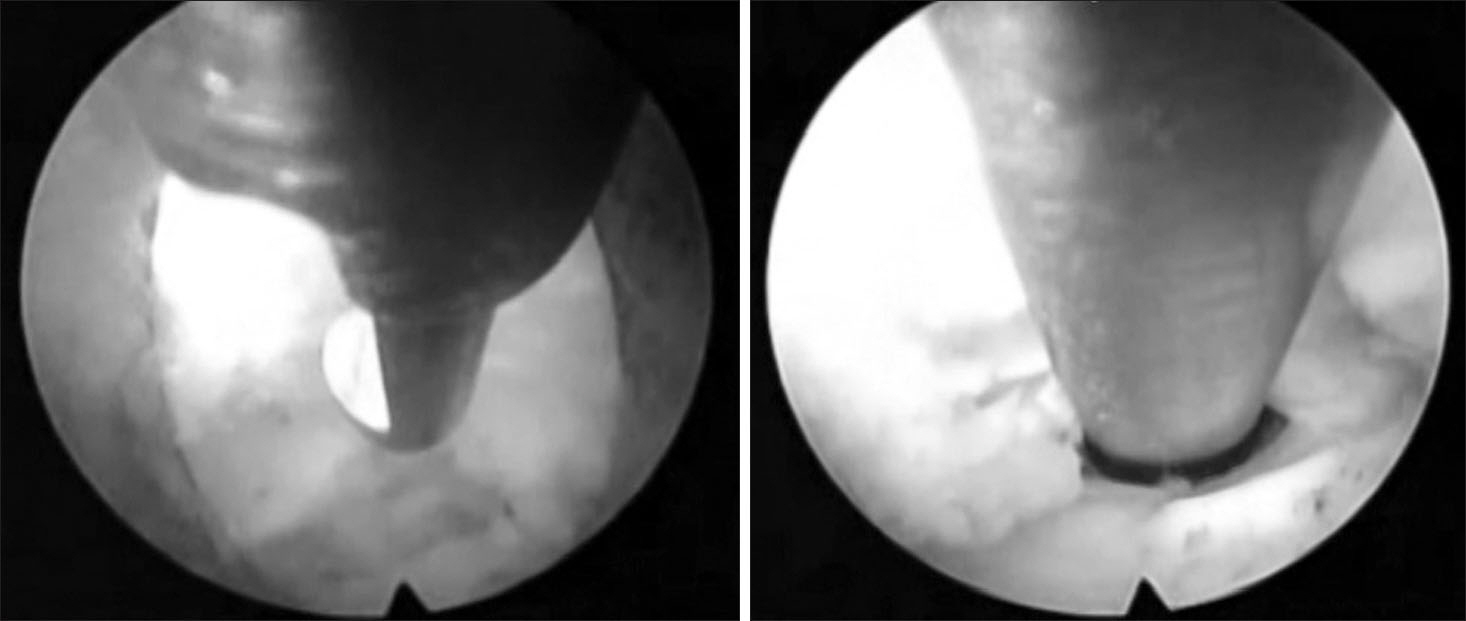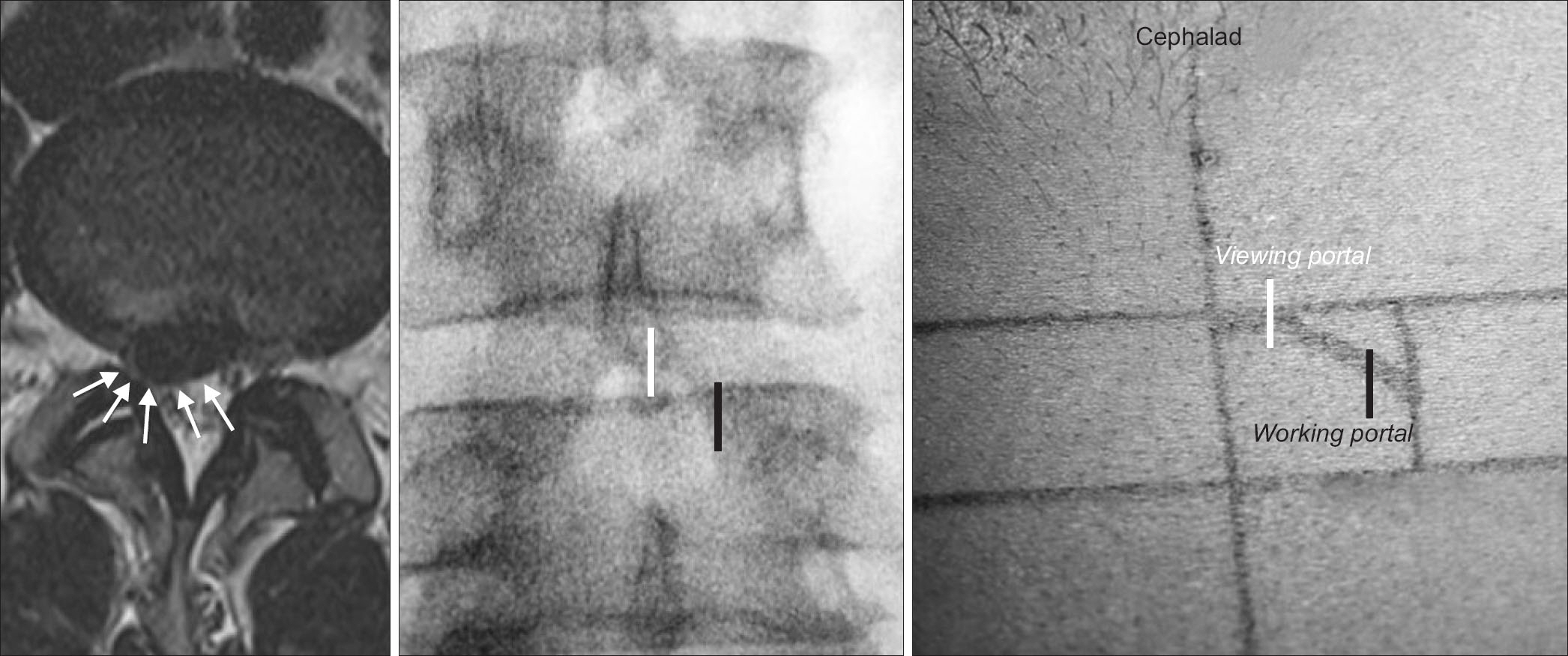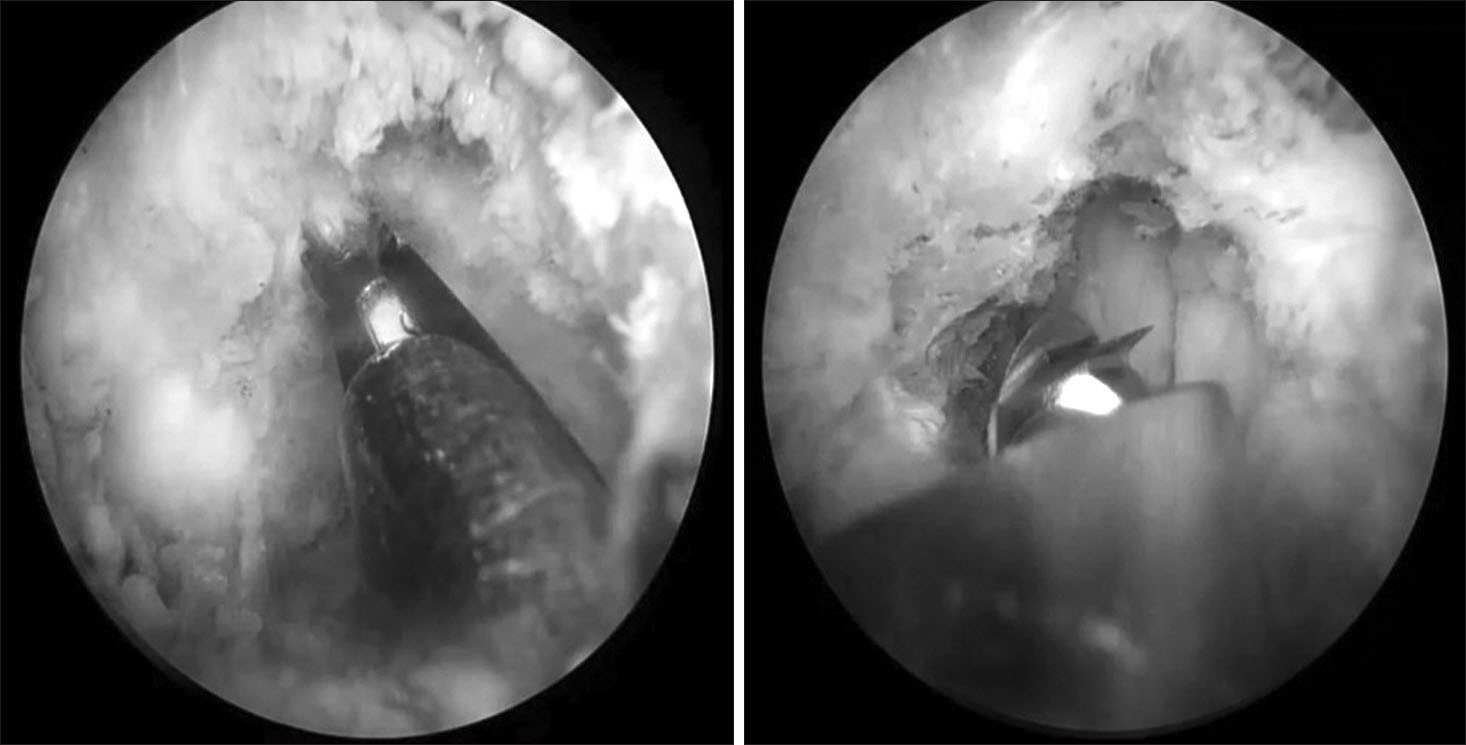J Korean Orthop Assoc.
2019 Jun;54(3):219-226. 10.4055/jkoa.2019.54.3.219.
Biportal Percutaneous Endoscopic Spinal Surgery for Lumbar Spinal Stenosis
- Affiliations
-
- 1Department of Orthopaedic Surgery, Korea University Anam Hospital, Korea University College of Medicine, Seoul, Korea. drspine90@kumc.or.kr
- KMID: 2450141
- DOI: http://doi.org/10.4055/jkoa.2019.54.3.219
Abstract
- Lumbar decompressive surgery is a standard surgery for lumbar spinal stenosis. Many surgical techniques have been introduced, ranging from open surgery to percutaneous procedures. Minimally invasive techniques are preferred because of the less postoperative pain and shorter hospital stay. Uniportal percutaneous endoscopic decompression has technical difficulties due to the narrow field. Biportal percutaneous endoscopic decompression is a satisfactory technique that can compensate for the shortcomings and provide sufficient decompression.
MeSH Terms
Figure
Reference
-
References
1. Arnoldi CC, Brodsky AE, Cauchoix J. . Lumbar spinal stenosis and nerve root entrapment syndromes. Definition and classification. Clin Orthop Relat Res. 1976. 115:4–5.
Article2. Buckwalter JA. Aging and degeneration of the human intervertebral disc. Spine (Phila Pa 1976). 1995. 20:1307–14.
Article3. Epstein JA, Epstein BS, Lavine LS, Carras R, Rosenthal AD, Sumner P. Lumbar nerve root compression at the intervertebral foramina caused by arthritis of the posterior facets. J Neurosurg. 1973. 39:362–9.
Article4. Johnsson KE, Rosén I, Udén A. The natural course of lumbar spinal stenosis. Clin Orthop Relat Res. 1992. 279:82–6.
Article5. Hu ZJ, Fang XQ, Zhou ZJ, Wang JY, Zhao FD, Fan SW. Effect and possible mechanism of muscle-splitting approach on multifidus muscle injury and atrophy after posterior lumbar spine surgery. J Bone Joint Surg Am. 2013. 95:e192(1-9).
Article6. Thongtrangan I, Le H, Park J, Kim DH. Minimally invasive spinal surgery: a historical perspective. Neurosurg Focus. 2004. 16:E13.
Article7. Eun SS, Eum JH, Lee SH, Sabal LA. Biportal endoscopic lumbar decompression for lumbar disk herniation and spinal canal stenosis: a technical note. J Neurol Surg A Cent Eur Neurosurg. 2017. 78:390–6.8. Amundsen T, Weber H, Nordal HJ, Magnaes B, Abdelnoor M, Lilleâs F. Lumbar spinal stenosis: conservative or surgical management?: a prospective 10-year study. Spine (Phila Pa 1976). 2000. 25:1424–35; discussion 1435-6.9. Malmivaara A, Slätis P, Heliövaara M. . Surgical or nonoperative treatment for lumbar spinal stenosis? A random-ized controlled trial. Spine (Phila Pa 1976). 2007. 32:1–8.10. Weinstein JN, Tosteson TD, Lurie JD. . Surgical versus nonoperative treatment for lumbar spinal stenosis four-year results of the spine patient outcomes research trial. Spine (Phila Pa 1976). 2010. 35:1329–38.
Article11. Verbiest H. A radicular syndrome from developmental narrowing of the lumbar vertebral canal. J Bone Joint Surg Br. 1954. 36:230–7.
Article12. Getty CJ. Lumbar spinal stenosis: the clinical spectrum and the results of operation. J Bone Joint Surg Br. 1980. 62:481–5.
Article13. Hides JA, Richardson CA, Jull GA. Multifidus muscle recovery is not automatic after resolution of acute, first-episode low back pain. Spine (Phila Pa 1976). 1996. 21:2763–9.
Article14. Weiner BK, Fraser RD, Peterson M. Spinous process osteotomies to facilitate lumbar decompressive surgery. Spine (Phila Pa 1976). 1999. 24:62–6.
Article15. Abumi K, Panjabi MM, Kramer KM, Duranceau J, Oxland T, Crisco JJ. Biomechanical evaluation of lumbar spinal stability after graded facetectomies. Spine (Phila Pa 1976). 1990. 15:1142–7.
Article16. Carreon LY, Puno RM, Dimar JR 2nd, Glassman SD, Johnson JR. Perioperative complications of posterior lumbar decompression and arthrodesis in older adults. J Bone Joint Surg Am. 2003. 85:2089–92.
Article17. Cassinelli EH, Eubanks J, Vogt M, Furey C, Yoo J, Bohlman HH. Risk factors for the development of perioperative complications in elderly patients undergoing lumbar decompression and arthrodesis for spinal stenosis: an analysis of 166 patients. Spine (Phila Pa 1976). 2007. 32:230–5.18. Kambin P, Gellman H. Percutaneous lateral discectomy of the lumbar spine a preliminary report. Clin Orthop Relat Res. 1983. 174:127–32.19. Kambin P, Sampson S. Posterolateral percutaneous suction-excision of herniated lumbar intervertebral discs. Report of interim results. Clin Orthop Relat Res. 1986. 207:37–43.
Article20. Kambin P. Arthroscopic microdiskectomy. Mt Sinai J Med. 1991. 58:159–64.21. Ki SC, Choi YS, Kim KS, Kuk WJ. Lumbar discectomy using tubular retractor and microendoscopy. J Korean Soc Spine Surg. 2008. 15:265–71.
Article22. Guiot BH, Khoo LT, Fessler RG. A minimally invasive technique for decompression of the lumbar spine. Spine (Phila Pa 1976). 2002. 27:432–8.
Article23. Watanabe K, Hosoya T, Shiraishi T, Matsumoto M, Chiba K, Toyama Y. Lumbar spinous process-splitting laminectomy for lumbar canal stenosis. Technical note. J Neurosurg Spine. 2005. 3:405–8.
Article24. Aryanpur J, Ducker T. Multilevel lumbar laminotomies: an alternative to laminectomy in the treatment of lumbar stenosis. Neurosurgery. 1990. 26::429-32; discussion 433..
Article25. Choi DJ, Choi CM, Jung JT, Lee SJ, Kim YS. Learning curve associated with complications in biportal endoscopic spinal surgery: challenges and strategies. Asian Spine J. 2016. 10:624–9.
Article26. Yeung AT, Tsou PM. Posterolateral endoscopic excision for lumbar disc herniation: Surgical technique, outcome, and complications in 307 consecutive cases. Spine (Phila Pa 1976). 2002. 27:722–31.27. Shin KH, Chang HG, Rhee NK, Lim KS. Revisional percutaneous full endoscopic disc surgery for recurrent herniation of previous open lumbar discectomy. Asian Spine J. 2011. 5:1–9.
Article28. Maroon JC, Abla A, Bost J. Association between peridural scar and persistent low back pain after lumbar discectomy. Neurol Res. 1999. 21:Suppl 1:S43–6.
Article29. Ahn Y. Percutaneous endoscopic decompression for lumbar spinal stenosis. Expert Rev Med Devices. 2014. 11:605–16.
Article30. Lee JH, Choi KC, Shim HK, Shin SH, Lee DC. Percutaneous biportal endoscopic surgery for lumbar degenerative diseases. J Minim Invasive Spine Surg Tech. 2017. 2:15–9.
Article31. Torudom Y, Dilokhuttakarn T. Two portal percutaneous endoscopic decompression for lumbar spinal stenosis: preliminary study. Asian Spine J. 2016. 10:335–42.
Article32. Sairyo K, Sakai T, Higashino K, Inoue M, Yasui N, Dezawa A. Complications of endoscopic lumbar decompression surgery. Minim Invasive Neurosurg. 2010. 53:175–8.
Article
- Full Text Links
- Actions
-
Cited
- CITED
-
- Close
- Share
- Similar articles
-
- Complications and Management of Endoscopic Spinal Surgery
- Current Status of Biportal Endoscopic Decompression for Lumbar Central Stenosis
- A Narrative Review of Biportal Endoscopic Spine Surgery in the Cervical and Thoracic Spine: Insights into Its Capabilities, Limitations, and Possibilities
- Biportal Endoscopic Transforaminal Lumbar Interbody Fusion with Arthroscopy
- Overview and Prevention of Complications During Biportal Endoscopic Lumbar Spine Surgery






